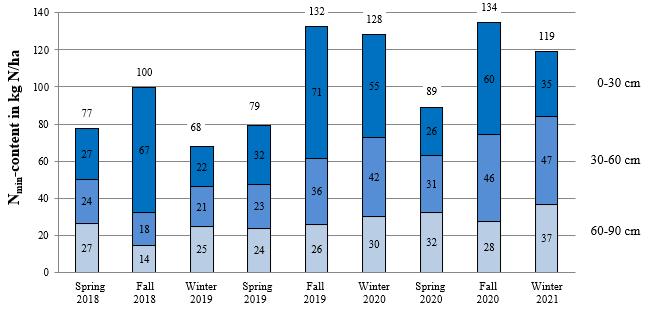
2 minute read
fertilizer systems (ID 6054
4.3 Nitrogen dynamics in hop gardens with different soil types and different fertilizer systems (ID 6054)
Sponsor: Bayerische Landesanstalt für Landwirtschaft, Institut für Pflanzenbau und Pflanzenzüchtung, AG Hopfenbau, Produktionstechnik (IPZ 5a) [Bavarian State Research Center for Agriculture, Institute for Plant Production and Plant Breeding, AG Hop Production, Production Technology (IPZ 5a)] Financing: Erzeugergemeinschaft HVG e. G. (HVG Hop Producer Group) Project Management: J. Portner Team: A. Schlagenhaufer Collaboration: Hallertau hop farms Duration: March 1, 2018 to February 28, 2021
Background
In the Hallertau, hops are cultivated intensively as a high-density specialty crop, principally because it generates very high added-value. In the past, therefore, the use of nitrogen fertilizers has never been a limiting production factor. In addition, older hop varieties are not very efficient in their nitrogen uptake, which is why, after the harvest, especially during drought and low-yield years, more residual nitrogen remains in the soil and poses a risk to other ecosystems.
Objectives
As part of the project, the nitrogen dynamics in hop soils are being investigated at 21 hop farms. In addition, intensive Nmin samples are being taken in the spring, fall, and winter. Finally, nitrogen requirements are determined for each of these locations, after which the amounts of nitrogen that were actually administered are tracked. The two values are then compared to determine nutrient utilization. As a result, the nitrogen path and its depletion potential during the vegetation period can be estimated for different types of farms, fertilizer systems, and soil types. This allows for the development of possible approaches for optimizing nitrogen management in hop cultivation. The aim is to optimize operational nitrogen management in such a way that the best yields and qualities can be achieved while observing and complying with the requirements of the Fertilizer Ordinance, without negatively impacting water protection requirements.
Method
In each of the 21 farms, 3 subareas were selected. The total of 63 subareas reflects the wide variety of hops grown in the Hallertau, as well as the different operating and fertilizing systems in use there. The first set of Nmin samples is collected at the start of the vegetation period in March; the second set, after the harvest in October to determine the residual amounts of nitrogen left in the soil; and the third, during the remaining vegetation period in the winter to determine any possible changes in Nlocations. As a convenient reference, the available nitrogen is measured as ammonium and nitrate, up to a soil depth of 90 cm. This sampling is divided into three 30-cm tiers to determine any N-shifts in the soil layers. Each farm receives individualized advice on fertilization issues. All nitrogen fertilizer applications are recorded in terms of quantity and timing. During the harvest, cones and residual plant matter are sampled to calculate the exact amount of nitrogen uptake. From this, an area-specific nutrient balance is assessed and related to the required Nmin content in the soil. Figure 4.7: Nmin soil-sampler
Results
After the initial trial years between 2018 and 2021, the first findings about nitrogen dynamics in hops could be compiled. The first nine samples show the distribution of Nmin values within the respective layers as a function of the sampling date (Figure 4.8). One early result of the study is the higher Nmin level, in the fall, in the top 30-centimeter section of the plant.

Figure 4.8: Nmin values taken on 9 sampling dates, divided by soil layers (n = 62)










